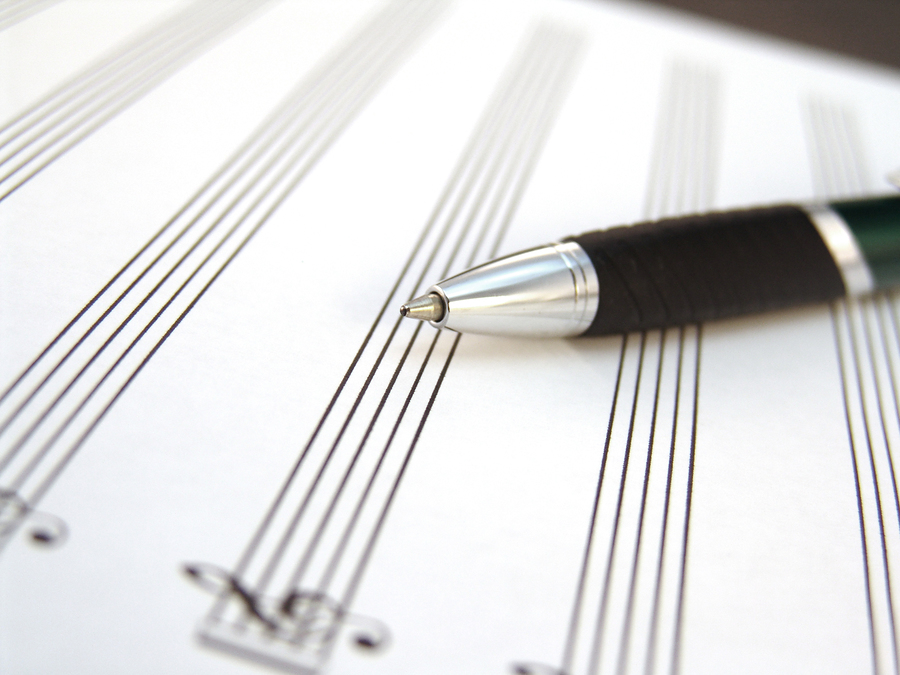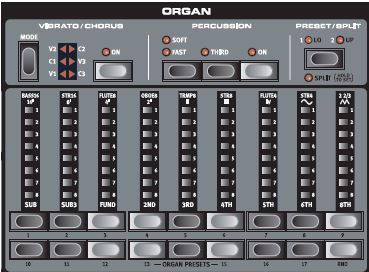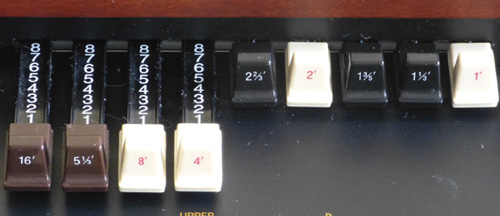

Composer
Setting up Registrations for your Nord Electro Dual Manual Organ
by Lou Di Falco
posted January 15, 2016Now that you have added a second keyboard to use with your Nord Electro 3 (or previous versions of the Electro), it’s time to discuss the registry settings for jazz playing. By the way, I am sure this stuff can be done with the newer Electro 4 and 5 however not owning one of those keyboards, I am not sure of the setup differences.
What I mean by registrations is the settings of the drawbars. On the NE3 and previous versions as well as all HP Electros, the drawbars are digital representations. Instead of a physical drawbar, there are two buttons below a column of red LEDs. Like the nine drawbars on a tone-wheel organ, there are nine of these columns on the NE3. The lower button is used to “pull out” (LEDs lit) while the upper button is used to “push in” (LEDs off).
The markings on the drawbars refer to feet, feet as in lengths of pipe. Remember that the Hammond Organ was designed as an electronic alternative to a pipe organ. The drawbars were designed to emulate the various lengths of pipes found on the ancestors of modern day organs. The settings from left to right for the nine drawbars are 16’, 5 1/2’, 8’, 4’, 2 2/3’, 2’, 1 3/5’, 1 1/3’ and 1’. The longer the length of pipe, the lower the tone. Foot lengths is how the drawbars are labeled on an actual Hammond Organ. The Nord uses labels on the digital drawbars indicating intervals and they are located just below the LEDs and above the drawbar buttons. See the contrasting images below.
Nord Electro 3 Organ Section
Hammond Drawbars
While there are many combinations of drawbar settings, you will be surprised to find that only a handful are used in most jazz settings. First we will focus on the lower manual that gets set once and then is left alone (for the most part). In this article like many other texts that indicate registration settings, I will use numbers to indicate the drawbar settings. For example, (88 8000 000) means the lower three drawbars are pulled all the way out (values can be 0-8) and the top six are off.
Press the Preset/Split button in the organ section so that 1/Lo is selected. Now the digital drawbars in the NE3’s organ section will control the lower keyboard. Pull out the 16’ and 8’ (press the lower drawbar buttons until all LEDs are lit) and leave the other drawbars pushed in (80 8000 000). This is a typical lower manual registration useful for playing left hand base and comping. You can also put out the 5 ˝’ drawbar to value 2 or 3 ( 82 8000 000) to add a bit more meat to the sound. Turn the chorus on and to the C3 setting. The lower manual is pretty much left alone now. While the upper manual will go through many registration changes throughout a tune or set, typically the lower manual never changes. It’s the base sound of the organ, no pun intended. Press the Preset/Split button again to set up the registrations for the top manual – 2/Up. But first, if you want an authentic Hammond experience you should check to make sure the following setting is in place.
Under Sound Menu (Shift-Sound), scroll down to parameter 9, Perc Drawbar 9 Cancel. Change to “C” for cancel. On an original Hammond C3/B3/A100, when the percussion is on, the 9th (right most) drawbar is canceled, in other words, it doesn’t sound. This had to do with the complicated wiring inside the organ as Hammond’s design robbed from a drawbar so the percussion could sound. But it turns out to be another unintended feature much like the key click and crosstalk that was considered anomalies in the original design. Now clone-wheel manufacturers go out of their way to model these “mistakes”. With this setting now set to cancel, we can create and store typical top manual registration.
Pull out the lowest three drawbars to full (88 8000 000). Set percussion to On with the 3rd harmonic (a fifth above the fundamental) and set decay to Fast and Soft. Turn on the chorus and set it to C3. Now the upper manual is set to the classic setting made famous by Jimmy Smith. Now pull out the right most drawbar (88 8800 008). If you changed the Perc Drawbar 9 Cancel setting described above, you should not hear any change in the sound. That’s intended. Turn off percussion and play. Now you will hear the highest drawbar in the mix but with no percussion. This sound is also a very common jazz setting. So now with the touch of a button (percussion on/off) you can toggle between two unique sounds, mimicking the experience of playing a real Hammond tone-wheel organ.
Four sounds are now available without much effort. On the top manual, the classic Jimmy Smith sound with chorus, without chorus, and the percussion off or on. Remember when off, the top drawbar will sound. Then there is the lower manual with its bass/comp setting. Playing only the lower manual is common when backing up other musicians and vocalists while the top manual is used to play melodies and improvisation.
Unfortunately unlike a real Hammond, there are no white on black preset keys on the NE3 (or any Nord product for that matter). However, there are preset buttons underneath the digital drawbars, 18 of them. (However, preset 18 randomly generate the drawbars and are useless for our purpose.)
Any drawbar setting can be stored as one of the 17 other presets. Unfortunately in a playing situation, it is rather clumsy to call them up because it requires two hands. The shift button has to be held while the preset button is pressed. This can be accomplished with one hand if you either have huge hands or your go-to presets are stored in the right most buttons, still a bit clumsy but manageable.
Before changing the drawbars, store the Jimmy Smith sound (88 8000 008) with percussion On in preset button 9. But first, realize these presets are already set to commonly used registrations right from the factory. Compare the factory presets with these registrations. They may already be there. With the Nord Sound manger, you can rearrange the presets very easily, moving them to the right side of the button group for easy access.
Another typical Hammond jazz setting is all drawbars out (known as “shout”, as in “shout chorus” - 88 8888 88) with the rotary speed set to Fast. Create this patch and store it in preset 17. Now with one hand, you can change to this setting by pressing the shift key with your right hand pinky (your left hand will be keeping the bass going) and preset button 17 key with your right thumb or index finger. Now to switch back to the Jimmy Smith setting, you will press preset 9 again. Note that rotary speed is not stored with the patch. It’s a good idea to use a footswitch to toggle between Leslie emulation Chorus and Tremolo.
Another great jazz registration is the Squabble, another setting made famous by Jimmy Smith attempting to emulate the sound of pianist Earl Garner. This setting is achieved with the four right most drawbars along with the single left most drawbar out full (80 0008 888). Store this preset in one of the right most preset buttons, perhaps 8 or 16. Set the rotation effect to fast and you are good to go. Now you have the most common Hammond settings for a jazz situation stored as presets.
One more setting of use is with all drawbars pushed in. What you say? Yep, you heard it right. Of course you need to have percussion set to on with the second harmonic selected. By the way, percussion as with an original Hammond C3/B3/A100 only works with the top manual and is only triggered when playing staccato. In other words, while playing legato you will notice that percussion doesn’t always sound. Each key press cycle must complete before percussion will trigger again.
Playing just percussion is a way to play a piano like passage and is useful when playing pianissimo. Percussion is not very loud but it is effective for quiet moments like at the end of a tune. It’s important to use the 2nd harmonic which is the fundamental. The 3rd harmonic is the 5th and with no drawbars pulled, you will be playing in a key a fifth higher than everyone else.
There you have it. You now have a two manual organ setup emulating the great Hammond Organ with the registrations needed to play jazz. Listen to the greats and glean as much as you can from them. Playing jazz organ is a blast.